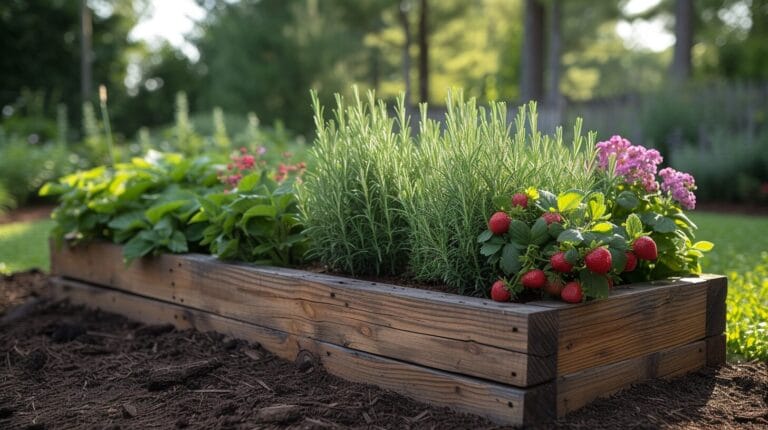Wind Tolerant Plants for Pots: Your Solution for Windy Balcony Gardens
Is the heavy wind on your balcony undermining your enjoyment of gardening? Don’t let it hinder you! By choosing plants that can withstand high winds, you can still grow a thriving and abundant garden in containers, even with the windy conditions.
Plants like agave, lavender, rosemary, and bamboo palm are champions of the plant world. They resist strong winds and add verdant life to your space. These resilient species combat the need for frequent replanting, supporting sustainable gardening efforts.
Dive into the world of pot-friendly, wind-tolerant plants and turn your windy balcony into a verdant oasis!
Key Points
- Wind-resistant plants such as agave, lavender, and rosemary are ideal for balconies in gusty areas.
- These plants withstand strong winds while enhancing your outdoor space with vibrant life.
- Growing wind-resistant plants in pots eliminates frequent replanting, promoting sustainable gardening practices.
Top Wind Resistant Plants for Pots and Balconies

Gardening can breathe life into your balcony, but certain plants struggle in windy conditions. Here are some top wind-resistant plants that thrive in pots and balconies:
- Agave: A sun lover that doesn’t require much water
- Aloe Vera: Strong, low maintenance, and versatile
- Bamboo Palm: Indoor air purifier with an aesthetic appeal
- Bird of Paradise: A beautiful flowering plant that brightens any space
- Lavender: Pleasantly scented with a love for sunlight
- Echinacea: A magnet for pollinators with pretty pink flowers
- Lantana: A colorful, summer-long bloomer
- Rosemary: Perfectly suited for pots and doubles up as a kitchen herb
- Sedum: A succulent that thrives in full sunlight and can resist dry periods
- Sempervivum (Hens-and-chicks): Resilient against cold winds and basks in full sunlight
Benefits of Wind Tolerant Plants for Pots

Potted wind-tolerant plants stand resolute on gusty days, resisting toppling over. This reduces frequent replanting, lessening the impact on your time and the environment. For instance, Agave, Aloe Vera, and Bird of Paradise stand admirably against the breeze. Not only do these resilient plants beautify your space, but they also provide satisfaction from withstanding harsh weather conditions.
Benefits of wind-tolerant plants video
Considerations when Choosing Plants for Windy Balconies
Choosing wind-tolerant plants requires thought. Here are key factors to consider:
- Pot size: Larger pots are often more stable in windy conditions.
- Soil type: Different plants prefer various soil types.
- Light needs: Some plants require full sun, others prefer indirect light.
- Watering: Balcony plants dry out faster due to wind. Choose drought-tolerant ones or commit to regular watering.
- Climate toleration: Plants must be suited to your local climate.
- Pest and disease resistance: Some plants are prone to diseases or pests.
- Growth control: Growing wind-tolerant plants in pots allows better growth management.
Choosing Plants for Windy Balconies video
Top Wind Tolerant Plants for Windy Balconies
Adding the appropriate wind-tolerant plants to your garden could decide between a thriving green space and a relentless struggle against the wind. Here are seven top plants that hold up against the wind and enhance your outdoor space with their aesthetic appeal:
| Plant Name | Description | Reason for Selection |
|---|---|---|
| Agave | Known for their rosette shape and stiff, succulent leaves. | Their tough, flexible leaves resist wind making them excellent wind-tolerant plants. |
| Aloe Vera | A succulent plant with beneficial medicinal properties. | Broad, flexible leaves handle wind well, and their large size provides a visual barrier against wind. |
| Bamboo Palm | Compact, tropical plants with lush foliage. | As a desert-adapted plant, it can resist wind, sun, and dry conditions. |
| Bird of Paradise | Known for its exotic, bird-like flowers. | Their flexible stems and leaves sway with the wind, reducing the risk of breakage. |
| English Lavender (Lavandula) | An aromatic evergreen sub-shrub, with purple flowers and grey-green leaves. | It can endure wind and direct sunlight, making it perfect for coastal and rooftop gardens. |
| Rosemary (Rosmarinus) | An aromatic evergreen shrub, with needle-like leaves and pale blue flowers. | Broad, flexible leaves handle wind well, and its large size provides a visual barrier against wind. |
| Nasturtium | A flowering plant producing bright, multi-colored blooms. | A robust plant that resists harsh conditions, including strong winds. Grows quickly, making it perfect for balconies. |
Remember, selecting the right wind-tolerant plants for your garden could greatly impact their survival and your gardening success. Wind-tolerant plants conserve gardening resources while thriving in windy conditions and adding to the aesthetic value of your balcony.
Real-Life Experience with Wind Tolerant Plants for Pots
Many have successfully grown wind-tolerant plants in pots. A gardener shared the success story of growing an Agave plant on their balcony. Despite gusty conditions, the Agave stood tall, with its resilient nature and deep root system perfectly suited to withstand the elements. Others have found Aloe Vera to be an ideal plant for exposed patios. These stories underscore the importance of choosing wind-tolerant plants for your garden.
Unique Wind Tolerant Plant – Sempervivum (Hens-and-chicks)
Sempervivum, or Hens-and-chicks, are small succulent plants that thrive in windy conditions due to their rosette-like structure with fleshy leaves. They add unique aesthetics while also being wind-tolerant.
Wind Tolerant Plants for Pots as Gifts
Wind-tolerant plants are great gifts due to their practicality and beauty. They promote sustainable gardening and the conservation of resources by withstanding strong winds. Gifting such plants reflects your care for the recipient and their environment.
Can Windy Conditions Cause Black Leaves on Plants in Balcony Gardens?
Strong winds can indeed lead to hidden dangers of black leaves in balcony gardens. These windy conditions can cause stress to plants, resulting in damaged leaves that turn black. It’s important to protect your green space from gusts by using wind barriers or selecting wind-resistant plants to avoid the negative effects of these hidden dangers.
Best Practices for Growing Wind Tolerant Plants in Pots
Here are some expert tips for successfully growing wind-tolerant plants:
- Use sturdy pots that won’t tip over easily.
- Ensure good drainage by using a well-draining potting mix.
- Select the correct plant size and corresponding pot size for stability.
- Place pots in locations shielded from the wind as much as possible.
- Regularly prune and maintain your plants for healthy growth and resilience.
- Avoid overwatering and maintain a regular watering schedule.
- Use supports for tall plants or those with weak stems.
Wrapping Up: Turn Your Windy Balcony into a Flourishing Garden
Choosing wind-tolerant plants is the secret to turning a gusty balcony into an eye-catching and sustainable garden.
These resilient plants reduce frequent replanting and withstand the roughest of weather, making your gardening passion a source of joy rather than stress.
Next, let’s explore how drought-tolerant pollinator plants can thrive alongside your wind-resistant potted favorites, creating a resilient and vibrant ecosystem right on your balcony!
FAQs
What are wind-tolerant plants for pots?
Wind-tolerant plants for pots withstand strong winds and grow well in windy conditions, like rosemary, lavender, or bamboo.
Can I grow these plants on a balcony?
Wind-resistant plants such as succulents and evergreen shrubs can be grown in pots, making them perfect for a balcony garden.
How do I care for the plants in a windy area?
Ensure you water the plant regularly, but don’t let it dry out completely. The pot also needs good drainage holes to prevent root rot from frequent watering.
Are there any low-maintenance, wind-tolerant herbs or vegetables?
Rosemary and Lavandula are low-maintenance herbs that tolerate high winds. At the same time, nasturtiums, an easy-to-grow flowering plant, is an option among vegetables.
What other factors should I consider when choosing outdoor plants for my balcony?
Consider your climate and how much direct sunlight your balcony gets; select wind-resistant yet sun-lovable potted dwarf variants of ferns or flowers accordingly.
Can wind-tolerant trees be considered as a part of my balcony gardening plan?
This is less likely due to their deep roots requirement; however, smaller resilient oak or hickory saplings might work if given plenty of room.







